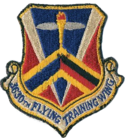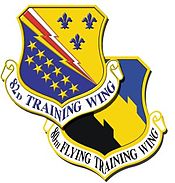

This article needs additional citations for verification. Please help improve this articlebyadding citations to reliable sources. Unsourced material may be challenged and removed.
Find sources: "Sheppard Air Force Base" – news · newspapers · books · scholar · JSTOR (February 2013) (Learn how and when to remove this message) |
| Sheppard Air Force Base | |||||||||||||
|---|---|---|---|---|---|---|---|---|---|---|---|---|---|
| Near Wichita Falls, Texas in the United States of America | |||||||||||||

Aircraft from the 80th Flying Training Wing and personnel from the 82nd Training Wing at Sheppard AFB.
| |||||||||||||
 | |||||||||||||
|
Show map of North America Show map of the United States Show map of Texas | |||||||||||||
| Coordinates | 33°59′20″N 098°29′31″W / 33.98889°N 98.49194°W / 33.98889; -98.49194 | ||||||||||||
| Type | US Air Force Base | ||||||||||||
| Site information | |||||||||||||
| Owner | Department of Defense | ||||||||||||
| Operator | US Air Force (USAF) | ||||||||||||
| Controlled by | Air Education and Training Command (AETC) | ||||||||||||
| Condition | Operational | ||||||||||||
| Website | www.sheppard.af.mil | ||||||||||||
| Site history | |||||||||||||
| Built | 1941 (1941) (as Sheppard Field) | ||||||||||||
| In use | 1941 – present | ||||||||||||
| Garrison information | |||||||||||||
| Current commander | Brigadier General George T.M. Dietrich III | ||||||||||||
| Garrison | |||||||||||||
| Airfield information | |||||||||||||
| Identifiers | IATA: SPS, ICAO: KSPS, FAA LID: SPS, WMO: 723513 | ||||||||||||
| Elevation | 310.5 metres (1,019 ft) AMSL | ||||||||||||
| |||||||||||||
| Airfield shared with Wichita Falls Municipal Airport. Source: Federal Aviation Administration[1] | |||||||||||||
Sheppard Air Force Base (IATA: SPS, ICAO: KSPS, FAA LID: SPS) is a United States Air Force (USAF) base located five miles (8.0 km) north of the central business district of Wichita Falls, in Wichita County, Texas, United States. It is the largest training base and most diversified in Air Education and Training Command. The base is named in honor of Texas Senator John Morris Sheppard, a supporter of military preparations before World War II.
The host unit at Sheppard is the 82d Training Wing (82 TRW), which provides specialized technical training and field training for officers, airmen and civilians of all branches of the U.S. military, other Department of Defense agencies and foreign nationals.
The 80th Flying Training Wing (80 FTW), also at Sheppard, conducts the Euro-NATO Joint Jet Pilot Training (ENJJPT) program, a multi-nationally manned and managed flying training program chartered to produce combat pilots for both USAF and NATO. This internationally manned and managed flying training program is the only one in the world.[2]
Brigadier General [1] George T.M. Dietrich III is the commander of the 82d Training Wing and he concurrently serves as the installation commander of Sheppard AFB. Colonel [2] Brad E. Orgeron is the commander of the 80th Flying Training Wing.
Sheppard AFB shares one runway with Wichita Falls Municipal Airport under a joint civil-military arrangement.
Sheppard Air Force Base is named in honor of Senator John Morris Sheppard of Texas (1875–1941), chairman of the Senate Military Affairs Committee from 1933 until his death on 9 April 1941. Senator Sheppard helped lead the fight for military preparedness before the attack on Pearl Harbor.
The base began as Sheppard Field on 300 acres (1.2 km2) just south of Kell Field. A Texas cattleman, oilman, and philanthropist, Joseph Sterling Bridwell, sold the land to the United States Army for one dollar.[3]
It was officially opened as a United States Army Air Corps training center on 17 October 1941, following the arrival of the first military members on 14 June. As the Army Air Corps became the Army Air Forces, facilities were completed sufficiently to allow the first class of 22 aviation mechanics to enter training that October; the class graduated 23 February 1942.
During World War II, then-Sheppard Field conducted basic training, and it also trained glider mechanics, technical and flying training instructors and B-29 Superfortress flight engineers. In addition to the basic flying training, the base also provided advanced pilot training.
Sheppard Field reached its peak strength of 46,340 people while serving as a separation center for troops being discharged following World War II from September through November 1945. Sheppard Field was deactivated 31 August 1946 and declared surplus to the War Department's needs. It was transferred to the jurisdiction of the United States Army Corps of Engineers 30 April 1947. Over the next two years the Texas National Guard used the base.

Control and accountability for Sheppard Field was transferred to the Department of the Air Force 1 August 1948 and was reactivated 15 August 1948 to supplement Lackland AFB, Texas, as a basic training center renamed as Sheppard AFB. Basic training was discontinued in June 1949, but was resumed from July 1950 to May 1952.
Over the next three decades, three training schools were stationed at the base training students in aircraft maintenance, transportation, communication, civil engineering, aircrew life support and field training.
The aircraft mechanics school was transferred to Sheppard from Keesler AFB, Mississippi in April 1949 to make room for expansion of electronic training at that base. The school was renamed the Department of Aircraft Maintenance Training within the 3750th Technical School. During the Korean War (1950–1953) several airmen from such places as Greece and Turkey were trained as mechanics.

Comptroller, transportation, and intelligence training moved to Sheppard from Lowry AFB, Colorado, in the fall of 1954. Communications, refrigeration, air conditioning, and power production operator and repairman training were transferred here from F.E. Warren AFB, Wyoming in 1959. Intelligence training returned to Lowry in February 1962. Training in certain missile systems began at Sheppard in 1957 and was conducted there through September 1985 when Titan II training operations were terminated following that weapon system's retirement.
The 3950th Technical Training Wing was designated the Sheppard Technical Training Center 1 January 1959. It has had two subsequent name changes and is now the 82d Training Wing.
Helicopter pilot training was transferred from Stead AFB, Nevada in October 1965, with H-19, H-43, Bell TH-1F, CH-3C and HH-3E helicopters used for training. Additional training in airborne firefighting was also conducted, given the role of the USAF HH-43 aircraft as a local rescue and aircraft firefighting asset at selected air force bases in the United States and at air bases overseas.
The 3630th Flying Training Wing was activated in 1965, and it assumed the helicopter training program. It began providing undergraduate pilot training in the T-37 and Northrop T-38 Talon for the then-West German Air Force in August 1966. Helicopter training was discontinued in 1971 when the U.S. Army assumed responsibility for training USAF helicopter pilots at Fort Rucker, Alabama.
The 3630th Flying Training Wing also provided undergraduate pilot training for pilots of the Republic of Vietnam Air Force from 1971 to 1975. The Wing designation was changed to the 80th Flying Training Wing on 1 January 1973.
The 80th Flying Training Wing began conducting the Euro-NATO Joint Jet Pilot Training Program in 1981. This one-of-a-kind program includes 13-NATO countries. They are: Belgium, Canada, Denmark, Germany, Greece, Italy, the Netherlands, Norway, Portugal, Spain, Turkey, the United Kingdom and the United States. Approval to conduct the program was recently extended through the year 2005.
The Air Force School of Health Care Sciences offered training in dentistry, medicine, nursing (to include flight nurse training), and health-services administration. The population of the base had declined to 3,825 in 1990.
In February 1992, restructuring and downsizing of the USAF caused a realignment and renumbering of units at Sheppard. Some of the training wings were redesignated as groups, and the technical training groups became squadrons.
Between 1960 and 1966 the Strategic Air Command (SAC) had training units stationed at the base that conducted aerospace rescue schools and weather instruction. In addition, The 494th Bombardment Wing, a SAC operational wing of B-52D Stratofortress bombers and KC-135A Stratotanker aircraft, previously designated as the 4245th Strategic Wing, was based at Sheppard from 1963 to 1966.
In July 1969, Detachment 1, 2nd Bombardment Wing, with four B-52 aircraft, became a tenant organization at Sheppard and remained until 1975. These aircraft rotated as part of SAC's dispersal concept and utilized the SAC Alert Facility on the northwest end of the airfield.
The DoD proposed a major realignment of the base, as part of the Base Realignment and Closure, 2005 program announced on 13 May 2005. DoD recommended relocating to Eglin AFB, Florida, front-line and instructor-qualified maintenance technicians and logistics support personnel to stand up the USAF's portion of the F-35 Lightning II Initial Joint Training Site there. This recommendation would establish Eglin AFB as the Initial Joint Training Site that would teach entry-level aviators and maintenance technicians how to safely operate and maintain the new F-35. Assuming no economic recovery, this recommendation could result in a maximum potential reduction of 487 jobs (295 direct jobs and 192 indirect jobs) over 2006–2011 in the Wichita Falls, TX, Metropolitan Statistical Area (0.5 percent).[4]

The host unit on Sheppard Air Force Base is the 82d Training Wing, whose mission makes it the most diversified training base within AETC. It is a non-flying wing that conducts all technical training at Sheppard. The 982d Training Group (982 TRG) provides instruction in a wide range of specialties at Sheppard and also at more than 60 USAF installations worldwide. The 82d Mission Support Group (82 MSG) and the 82 Medical Group (82 MDG) support these organizations. Together with the 80th Flying Training Wing more than 7 million U.S. and allied warriors have been trained.
The 80th Flying Training Wing's mission is "To produce NATO pilots with the skills and attitude to succeed in fighter aviation". It is home of the Euro-NATO Joint Jet Pilot Training (ENJJPT) Program. It is a uniquely manned multinational organization with a USAF wing commander and a German Air Force operations group commander in the top two leadership positions. Command and operations officers' positions in the flying training squadrons rotate among the participating nations, while the commander of the 80th Operations Support Squadron is always from the USAF.
Officers from all 13 participating nations fill subordinate leadership positions throughout the wing. Nine nations--Belgium, Denmark, Germany, Italy, The Netherlands, Norway, Turkey, Spain and the United States—provide instructor pilots based on their number of student pilots. Canada, Greece and Spain do not have student pilots in training, but do provide one instructor pilot. The current non-active signatory nations, the United Kingdom and Portugal, do not send student pilots nor do they provide instructor pilots, but retain the right to do so at any time.

Operational training squadrons are:
Flying and notable non-flying units based at Sheppard Air Force Base.[5][6][7]
Units marked GSU are Geographically Separate Units, which although based at Sheppard, are subordinate to a parent unit based at another location.
|
Air Education and Training Command (AETC)
|
Air Force Reserve Command (AFRC)
|
|
| |||||||||||
|---|---|---|---|---|---|---|---|---|---|---|---|
| Leadership |
|
| |||||||||
| Structure |
| ||||||||||
| Personnel and training |
| ||||||||||
| Uniforms and equipment |
| ||||||||||
| History and traditions |
| ||||||||||
| |||||||||||
|
| ||
|---|---|---|
| Air Forces |
| |
| Bases |
| |
| Wings |
| |
| Groups |
| |
| International |
|
|---|---|
| National |
|